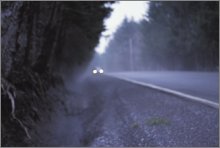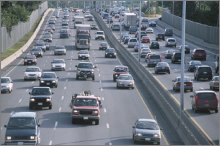How Typical Roadside Dirt Can Pose Serious Health Risks to You
by www.SixWise.com
While many studies have honed in on the devastating effects
of car exhaust, diesel fumes, and their impact on the
air surrounding urban, and even rural, areas, few have ventured
to look into the composition of roadside dirt, and how it
could be affecting Americans' health.
Roadside dirt, which is circulated into the air when cars
and trucks pass by, is actually full of non-tailpipe vehicle
emissions, such as microscopic metal particles from brake
and tire wear, according to researchers from the University
of Wisconsin-Madison.
|

Dirt kicked up from roadways was found to contain metal
particles from brake and tire wear, along with fragments
of lead weights used to balance tires.
|
In addition to tiny particles of brakes and tires, road dust
was found to contain platinum-group metals from catalytic
converters and fragments of the lead weights used to balance
tires.
Breathing in Brakes and Tires?
What, then, are the potential health effects of breathing
in microscopic particles of car parts like brakes and tires?
An increased risk of asthma and lung disease, for starters,
and that's just touching the surface, especially for those
who live near busy roads.
"We know that metals can be important in toxicity and
adverse health," says James Schauer, an associate professor
of civil and environmental engineering at UW-Madison.
The research team gathered much of their data from the Milwaukee,
Wisconsin area, using several methods:
-
They measured pollutants at the entrances and exits of
various streets.
-
They vacuumed roadways, circulated the dirt in the lab
and collected it on filters, then analyzed the samples.
-
They collected air samples in Milwaukee, Waukesha, Wisconsin
and Denver, Colorado to compare metal concentrations in
the air with those found on roadways.
-
They identified non-tailpipe auto emissions by testing
vehicles in a sealed room on a California Air Resources
Board running-loss-shed dynamometer.
-
They determined what fraction of the metals dissolved
in a synthetic fluid similar to human lung fluid.
Roadside Dirt and Your Health
Part of the major reason why the particles in roadside dirt
may be harmful is their ability to dissolve in liquid, and
the concern that many of the particles are metals.
"A high percentage of the metals
that are in these particles actually are liquid-soluble or
soluble in this surrogate lung fluid, which again could be
important to the health community to begin to understand what's
important," says Schauer. "Our data would
suggest that the reason we see adverse health effects is because
of all of these metals that are present in these materials
-- which makes it different from rural dirt."
"The broader picture of this is that these metals need
to be thought of in the context of adverse health effects
from roadways," he says.
How to Protect Yourself From Roadside Dirt and Air Pollution
|

Air pollution is typically highest during the mid-day
and afternoon, so staying away from highways and other
heavily trafficked areas during these times, particularly
when ozone levels are high, may help reduce your risk.
|
Avoiding any kind of pollution from roadside dirt, diesel
fumes and car exhaust is not easy, unless you live in a very
isolated, pristine location. Still, about 4 percent of deaths
in the United States can be attributed to air pollution, according
to the Environmental Science Engineering Program at the Harvard
School of Public Health -- and that doesn't include any potential
health damage from inhaling roadside dirt.
So for those of us living in the country's cities, suburbs
and in between, what are the options? There are several steps
you can take to reduce your risk of air pollution, both in
and outside of your home.
-
Keep Dirt and Dust Out of Your Home. A few high-quality
mats, like the Waterhog
Grand Premier Mats, placed strategically around your
home (such as in doorways and other highly trafficked
areas), will go a long way toward reducing the amount
of dirt and dust in your home in the first place. Once
inside, that dirt gets circulated into the air and you
breathe it in.
-
Avoid high levels of smog and pollution. These
are typically highest during the midday and afternoon.
If you're in a high-risk group, don't go outside when
ozone levels are high.
-
Exercise when the air is cleaner. When we exercise
(or work strenuously), we draw air more deeply into our
lungs, and therefore risk more damage from air pollution.
To protect yourself and get the numerous
health benefits of exercise, avoid exercising near
congested streets and during rush-hour traffic, and try
to work out early in the morning or evening instead.
- Proper Cleaning. A significant amount of toxins
in your indoor air may come from dirt
and dust that, through everyday living, end up on almost
every surface in your home. Cleaning these surfaces is therefore
necessary to reduce the toxins in your air, as, similar
to roadside dirt, when you walk around you stir up that
dirt and dust into the air you breathe.
However, if you use ordinary rags or mops, you will simply
push dirt from one area to another -- NOT pick it up and
eliminate it like you intended. That's why we recommend
PerfectClean
mops, cloths and dusters to give your home a microscopic
level of clean.
-
Roll up Your Car Windows. If you come across
a cloud of dirt along the highway (particularly during
construction, etc.), roll up your windows until the air
clears. Although you won't be able to keep everything
out, it may keep the bulk of the pollution outside of
your car, and your lungs.
Recommended Reading
Air
Pollution: Check to See What Grade Your County Received, and
the Cleanest & Dirtiest Air in America
Exposure
to Air Pollution Linked to Genetic Abnormalities
Sources
Health
Effects Institute: Characterization of Metals Emitted From
Motor Vehicles
University
of Wisconsin-Madison June 29, 2006